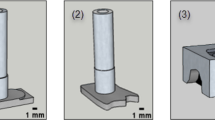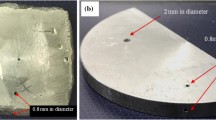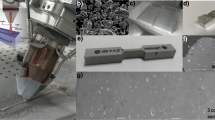Abstract
The die-casting process creates the opportunity to design and manufacture complex parts in different industrial fields. However, the presence of micro-porosity and cracks can significantly impact the functionality and lifetime of the components. The impregnation technique improves the defect and upgrades the alloy's usability. Hence, identifying the impregnation technique's usefulness in sealing porosity is vital for enhancing the quality of the die casting products. It is hard to detect low atomic number impregnation resin located in the casting defects due to low X-ray attenuation. In this study, microfocus X-ray computed tomography (XCT) with advanced direct conversion detectors could effectively be employed to visualize casting defects in 3D. Also, to recognize the impregnated resin in Al-alloy both qualitatively and quantitatively. Dual-energy XCT recognized the resin material as P601 super sealant quantitatively. Casting defects could be identified in 2D CT images, and it is not easy to detect the impregnated resin with simple intensity-based image processing algorithms. Hence, an approach to improve resin detection through machine learning was studied. With a random forest classifier, trainable weka segmentation was used with three pre-defined classes. It precisely segmented the casting pore, Al-alloy, and resin material after well-trained the known data set.

















Similar content being viewed by others
References
Stöhr J, Scherz A (2015) Creation of X-ray transparency of matter by stimulated elastic forward scattering. Phys Rev Lett 115(10):107402
Chen XF, Song JB, Chen XY, Yang HH (2019) X-ray-activated nanosystems for theranostic applications. Chem Soc Rev 48(11):3073–3101
Cao C, Toney MF, Sham T-K et al (2020) Emerging X-ray imaging technologies for energy materials. Mater Today 34:132–147
Akman F, Durak R, Turhan MF, Kaçal MR (2015) Studies on effective atomic numbers, electron densities from mass attenuation coefficients near the K edge in some samarium compounds. Appl Radiat Isot 101:107–113
Kamkaew A, Chen F, Zhan YH, Majewski RL, Cai WB (2016) Scintillating nanoparticles as energy mediators for enhanced photodynamic therapy. ACS Nano 10(4):3918–3935
Zhou Y, Chen J, Bakr OM, Mohammed OF (2021) Metal halide perovskites for X-ray imaging scintillators and detectors. ACS Energy Lett 6(2):739–768
Nikl M, Yoshikawa A (2015) Recent R&D trends in inorganic single-crystal scintillator materials for radiation detection. Adv Opt Mater 3(4):463–481
Bossi RH, Cline JL, Georgeson GE (1991) X-ray computed tomographic inspection of castings. Rev Progress Quant Nondestr Eval 10B:1883–1790
Bossi R, Crews A, Georgeson G, Nelson J, Shrader J (1993) X-ray computed tomography for geometry acquisition. Rev Progress Quant Nondestr Eval 12:343–349
Georgeson G, Bossi R (1993) X-ray CT for quantitative casting material evaluation. Rev Progress Quant Nondestr Eval 12:1681–1688
Neel ST, Eliasen DS, Yancey RN (1995) Dimensional measurement of internal features in complex castings. Rev Progress Quant Nondestr Eval 14:689–694
Neel ST, Yancey RN (1996) X-ray computed tomography application in research. Rev Progress Quant Nondestr Eval 15:497–502
Neel ST, Gibson R, Daniels CR (1998) Dimensional accuracy in X-ray computed tomographic imaging. Rev Progress Quant Nondestr Eval 17:411–418
Bartscher M, Neuschaefer-Rube U, Wäldele F (2004) Computed tomography—a highly potential tool for industrial quality control and production near measurement. In: 8th International Symposium on Measurement and Quality Control in Production, Erlangen, Germany, pp 3–8
Reinhart C, Poliwoda C, Guenther T, Roemer W, Maas S, Gosch C (2004) Modern voxel based data and geometry analysis software tools for industrial CT. In: 16th World Conference on NDT, Montreal, Canada, p 1–8
Reinhart C (2008) Industrial computer tomography—a universal inspection tool. In: 17th world conference on nondestructive testing. 25–28 Oct 2008, Shanghai, China
Thompson A, Leach R (2018) Introduction to industrial X-ray computed tomography. In: Carmignato S, Dewulf W, Leach R (eds) Industrial X-ray computed tomography. Springer, Cham, pp 1–23
Ohno Y, Torikoshi M, Tsunoo T, Hyodo K (2005) Dual-energy X-ray CT with CdTe array and its extension. Nucl Instrum Methods Phys Res Sect A 548:72–77. https://doi.org/10.1016/j.nima.2005.03.069
Kastner J, Heinzl C (2015) X-ray computed tomography for non-destructive testing and materials characterization. In: Liu Z, Ukida H, Ramuhalli P, Niel K (eds) Integrated imaging and vision techniques for industrial inspection. Springer, London, pp 227–250
Buratti A, Bredemann J, Pavan M, Schmitt R, Carmignato S (2018) "Applications of CT for dimensional metrology. In: Carmignato S, Dewulf W, Leach R (eds) Industrial X-ray computed tomography. Springer, Cham, pp 333–369
Garcea SC, Wang Y, Withers PJ (2018) X-ray computed tomography of polymer composites. Compos Sci Technol 156:305–319
Hellier CJ (2013) Handbook of nondestructive evaluation, 2nd edn. McGraw-Hill, Columbus
Kastner J, Harrer B, Degischer HP (2011) High resolution cone beam X-ray computed tomography of 3D-microstructures of cast Al-alloys. Mater Charact 62:99–107
Du Plessis A, Rossouw P (2015) X-ray computed tomography of a titanium aerospace investment casting. Case Stud Nondestruct Test Eval. https://doi.org/10.1016/j.csndt.2015.03.001
Shahani AJ, Xiao X, Lauridsen EM, Voorhees PW (2020) Characterization of metals in four dimensions. Mater Res Lett 8(12):462–476. https://doi.org/10.1080/21663831.2020.1809544
Kan K, Imura Y, Morii H, Kobayashi K, Minemura T, Aoki T (2013) Application of photon-counting X-ray computed tomography to aluminum-casting inspection. World J Nucl Sci Technol 3:106–108
Bandara A, Kan K, Morr H, Koike A, Aoki T (2019) X-ray computed tomography to investigate industrial cast Al-alloys. Prod Eng. https://doi.org/10.1007/s11740-019-00946-8.2019.12.20
Xiangjie Ma, Martin B, Ewald U, Peter H (2021) Classification of X-ray attenuation properties of additive manufacturing and 3D printing materials using computed tomography from 70 to 140 kVp. Front Bioeng Biotechnol 9:763960. https://doi.org/10.3389/fbioe.2021.763960
Martz HE, Logan CM, Schneberk DJ, Peter J (2016) X-ray imaging. CRC Press, Boca Raton
Arganda-Carreras I, Kaynig V, Rueden C, Eliceiri KW, Schindelin J, Cardona A, Sebastian Seung H (2017) Trainable Weka segmentation: a machine learning tool for microscopy pixel classification. Bioinformatics 33(15):2424–2426. https://doi.org/10.1093/bioinformatics/btx180
Furat O, Wang M, Neumann M et al (2019) Machine learning techniques for the segmentation of tomographic image data of functional materials. Front Mater 6:145
Dobens AC, Dobens LL (2013) FijiWings: an open source toolkit for semiautomated morphometric analysis of insect wings. G3 (Bethesda) 3:1443–1449
Krueger MA, Huke SS, Glenny RW (2013) Visualizing regional myocardial blood flow in the mouse. Circ Res 112:e88–e97
Hart N, Huang L (2012) Monitoring nests of solitary bees using image processing techniques. In: 19th International Conference on Mechatronics and Machine Vision in Practice (M2VIP), Auckland, New Zealand, November 28–30, 2012. IEEE Explore, pp 1–4
Kulinowski P, Dorozynski P, Mlynarczyk A, Weglarz WP (2011) Magnetic resonance imaging and image analysis for assessment of HPMC matrix tablets structural evolution in USP apparatus 4. Pharm Res 28:1065–1073
Mathew MD, Mathew ND, Ebert PR (2012) WormScan: a technique for high-throughput phenotypic analysis of Caenorhabditis elegans. PLoS ONE 7:e33483
Favazza TL, Tanimoto N, Munro RJ, Beck SC, Garrido MG, Seide C, Sothilingam V, Hansen RM, Fulton AB, Seeliger MW, Akula JD (2013) Alterations of the tunica vasculosa lentis in the rat model of retinopathy of prematurity. Doc Ophthalmol 127:3–11
Maiora J, Graña M (2012) Abdominal CTA image analysis through active learning and decision random forests: application to AAA segmentation. In: The 2012 International Joint Conference on Neural Networks (IJCNN), Brisbane, Australia, June 10–15, 2012. IEEE Explore, pp 1–7
Macdonald W, Shefelbine S (2013) Characterising neovascularisation in fracture healing with laser Doppler and micro-CT scanning. Med Biol Eng Comp 51:1157–1165
Mutiargo B, Garbout A, Malcolm A (2019) Defect detection using trainable segmentation. 61. https://doi.org/10.1117/12.2521768
Fuchs P, Kröger T, Garbe CS (2021) Defect detection in CT scans of cast aluminum parts: a machine vision perspective. Neurocomputing 453:85–96. https://doi.org/10.1016/j.neucom.2021.04.094 (ISSN 0925-2312)
Chen S, Kaufmann T (2022) Development of data-driven machine learning models for the prediction of casting surface defects. Metals 12(1):1. https://doi.org/10.3390/met12010001
Blondheim D (2022) Improving manufacturing applications of machine learning by understanding defect classification and the critical error threshold. Inter Metalcast 16:502–520. https://doi.org/10.1007/s40962-021-00637-0
Ho TK (1995) Random decision forests (PDF). In: Proceedings of the 3rd International Conference on Document Analysis and Recognition, Montreal, QC, 14–16 August 1995. pp 278–282. Archived from the original (PDF) on 17 April 2016. Retrieved 5 June 2016
Ho TK (1998) The random subspace method for constructing decision forests. IEEE Trans Pattern Anal Mach Intell 20(8):832–844. https://doi.org/10.1109/34.709601
Hastie T, Tibshirani R, Friedman J (2008) The elements of statistical learning, 2nd edn. Springer (ISBN 0-387-95284-5)
Kyrieleis A, Titarenko V, Ibison M, Connolley T, Withers PJ (2010) Region-ofinterest tomography using filtered backprojection: assessing the practical limits. J Microsc 241:69–82
Muders J, Hesser J, Lachner A, Reinhart C (2011) Accuracy evaluation and exploration of measurement uncertainty for exact helical cone beam reconstruction using katsevich filtered back projection in comparison to circular Feldkamp reconstruction with respect to industrial CT metrology. In: International Symposium on Digital Industrial Radiology and Computed Tomography, Berlin, Germany
Kikinis R, Pieper SD, Vosburgh K (2014) 3D slicer: a platform for subject-specific image analysis, visualization, and clinical support. In: Jolesz FA (ed) Intraoperative imaging image-guided therapy, 3(19):277–289 ISBN: 978-1-4614-7656-6 (Print) 978-1-4614-7657-3
Schindelin J, Arganda-Carreras I, Frise E et al (2012) Fiji: an open-source platform for biological-image analysis. Nat Methods 9(7):676–682. https://doi.org/10.1038/nmeth.2019 (PMID22743772, on Google Scholar)
de Oliveira FB, Stolfi A, Bartscher M, Chiffre L, Neuschaefer-Rube U (2016) Experimental investigation of surface determina-tion process on multi-material components for dimensional computed tomography. Case Stud Nondestruct Test Eval. https://doi.org/10.1016/j.csndt.2016.04.003
Reiter M, Weiß D, Gusenbauer C, Erler M, Kuhn C, Kasperl S, Kastner J (2014) Evaluation of a histogram-based image quality measure for X-ray computed tomography. In: Proceeding’s 5th conference on industrial computed tomography (iCT 2014). Wels, Austria, NDT.net Issue, pp 273–282
Nowotny R (1998) XMuDat: photon attenuation data on PC. IAEA-NDS-195 International Atomic Energy Agency, Vienna, Austria. http://www.mds.iaea.or.at/reports/mds-195.htm
Jackson DF, Hawkes DJ (1981) X-ray attenuation coefficients of elements and mixtures. Phys Rep 70(3):169–233
Hawkes DJ, Jackson DF (1980) An accurate parametrisation of the X-ray attenuation coefficient. Phys Med Biol 25(6):1167–1171
Acknowledgements
The authors extend their appreciation to the members of ANSeeN Inc for their technical and instrument support to the XCT.
Funding
This research did not receive any specific grant from funding agencies in the public, commercial, or not-for-profit sectors.
Author information
Authors and Affiliations
Corresponding author
Ethics declarations
Conflict of interest
The authors declare that they have no conflict of interest.
Additional information
Publisher's Note
Springer Nature remains neutral with regard to jurisdictional claims in published maps and institutional affiliations.
Rights and permissions
About this article
Cite this article
Yusuke, K., Bandara, A., Soga, N. et al. Investigation of industrial die-cast Al-alloys using X-ray micro-computed tomography and machine learning approach for CT segmentation. Prod. Eng. Res. Devel. 17, 291–305 (2023). https://doi.org/10.1007/s11740-022-01147-6
Received:
Accepted:
Published:
Issue Date:
DOI: https://doi.org/10.1007/s11740-022-01147-6




